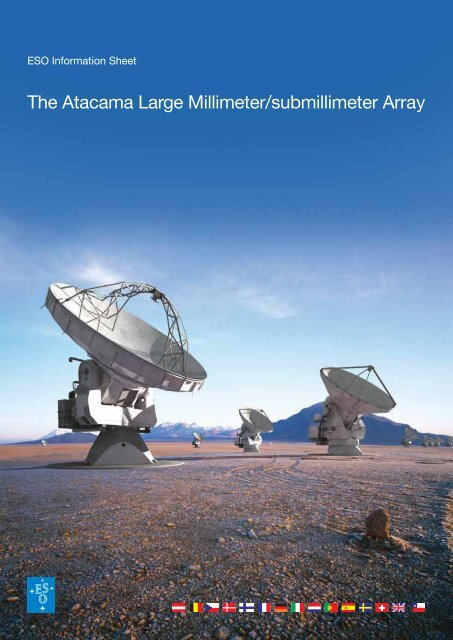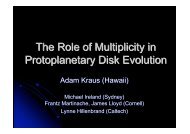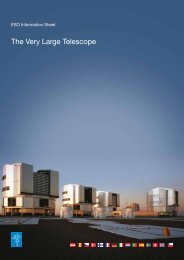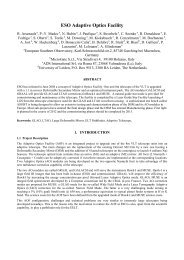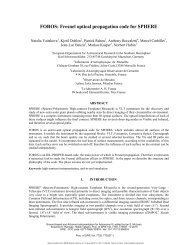The Atacama Large Millimeter/submillimeter Array - ESO
The Atacama Large Millimeter/submillimeter Array - ESO
The Atacama Large Millimeter/submillimeter Array - ESO
Create successful ePaper yourself
Turn your PDF publications into a flip-book with our unique Google optimized e-Paper software.
<strong>ESO</strong> Information Sheet<br />
<strong>The</strong> <strong>Atacama</strong> <strong>Large</strong> <strong>Millimeter</strong>/<strong>submillimeter</strong> <strong>Array</strong>
ALMA — in search of our cosmic origins<br />
High on the Chajnantor plateau in the<br />
Chilean Andes, the European Southern<br />
Observatory (<strong>ESO</strong>), together with its international<br />
partners, is building the <strong>Atacama</strong><br />
<strong>Large</strong> <strong>Millimeter</strong>/<strong>submillimeter</strong> <strong>Array</strong>,<br />
ALMA — a state-of-the-art telescope<br />
to study light from some of the coldest<br />
objects in the Universe. This light has a<br />
typical wavelength of around a millimetre,<br />
between infrared light and radio waves,<br />
and is therefore known as millimetre and<br />
submillimetre radiation.<br />
Light at these wavelengths shines from<br />
vast cold clouds in interstellar space, at<br />
temperatures only a few tens of degrees<br />
above absolute zero, and from some of<br />
the earliest and most distant galaxies in<br />
the Universe. Astronomers can use it to<br />
study the chemical and physical conditions<br />
in molecular clouds — the dense<br />
regions of gas and dust where new stars<br />
are being born. Often these regions of the<br />
Universe are dark and obscured in visible<br />
light, but they shine brightly in the millimetre<br />
and submillimetre part of the spectrum.<br />
Millimetre and submillimetre radiation<br />
opens a window into the enigmatic cold<br />
Universe, but the signals from space are<br />
heavily absorbed by water vapour in the<br />
Earth’s atmosphere. Telescopes for this<br />
kind of astronomy must be built on high,<br />
dry sites, such as the 5000-metre high<br />
plateau at Chajnantor, site of the highest<br />
astronomical observatory on Earth.<br />
Here <strong>ESO</strong> is building ALMA, the largest<br />
astronomical project in existence.<br />
<strong>The</strong> ALMA site, some 50 km east of San<br />
Pedro de <strong>Atacama</strong> in northern Chile,<br />
is in one of the driest places on Earth.<br />
Astronomers find unsurpassed conditions<br />
for observing, but they must operate a<br />
frontier observatory under very difficult<br />
conditions. Chajnantor is more than<br />
750 m higher than the observatories on<br />
Mauna Kea, and 2400 m higher than the<br />
VLT on Cerro Paranal.<br />
ALMA will be a single telescope of revolutionary<br />
design, composed initially of 66<br />
high precision antennas, and operating at<br />
wavelengths of 0.3 to 9.6 mm. Its main<br />
12-metre array will have fifty antennas,<br />
12 metres in diameter, acting together as<br />
a single telescope – an interferometer. An<br />
additional compact array of four 12-metre<br />
and twelve 7-metre antennas will complement<br />
this. <strong>The</strong> antennas can be moved<br />
across the desert plateau over distances<br />
from 150 metres to 16 kilometres, which<br />
will give ALMA a powerful variable “zoom”.<br />
It will be able to probe the Universe at<br />
millimetre and submillimetre wavelengths<br />
with unprecedented sensitivity and resolution,<br />
with a vision up to ten times sharper<br />
than the Hubble Space Telescope, and<br />
complementing images made with the VLT<br />
Interferometer.<br />
ALMA is the most powerful telescope for<br />
observing the cool Universe — molecular<br />
gas and dust as well as the relic radiation<br />
of the Big Bang. ALMA will study the<br />
building blocks of stars, planetary systems,<br />
galaxies, and life itself. By providing<br />
scientists with detailed images of stars<br />
and planets being born in gas clouds near<br />
our Solar System, and detecting distant<br />
galaxies forming at the edge of the observable<br />
Universe, which we see as they<br />
were roughly ten billion years ago, it will let<br />
astronomers address some of the deepest<br />
questions of our cosmic origins.<br />
ALMA’s construction will be completed<br />
around 2012, but early scientific observations<br />
with a partial array will begin around<br />
2011.<br />
<strong>The</strong> ALMA Project is a partnership between<br />
the scientific communities of East Asia,<br />
Europe and North America with Chile.<br />
www.eso.org/alma<br />
www.almaobservatory.org/<br />
Moving an ALMA Antenna<br />
About <strong>ESO</strong><br />
<strong>ESO</strong>, the European Southern Observatory, is the foremost intergovernmental astronomy organisation in Europe. It is supported by 14<br />
countries: Austria, Belgium, the Czech Republic, Denmark, France, Finland, Germany, Italy, the Netherlands, Portugal, Spain, Sweden,<br />
Switzerland and the United Kingdom.<br />
<strong>ESO</strong> carries out an ambitious programme focused on the design, construction and operation of powerful ground-based observing<br />
facilities enabling astronomers to make important scientific discoveries. <strong>ESO</strong> plays also a leading role in promoting and organising<br />
cooperation in astronomical research.<br />
<strong>ESO</strong> operates three unique world-class observing sites in the <strong>Atacama</strong> Desert region of Chile: La Silla, Paranal and Chajnantor.<br />
<strong>ESO</strong><br />
Education and Public Outreach Department<br />
Karl-Schwarzschild-Straße 2<br />
85748 Garching bei München<br />
Germany<br />
Tel. +49 89 3200-6291<br />
Fax +49 89 3200-6703<br />
Email information@eso.org<br />
www.eso.org


